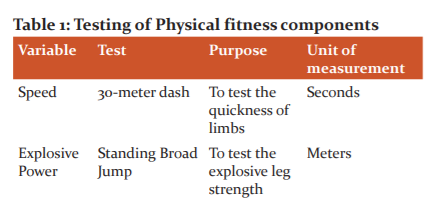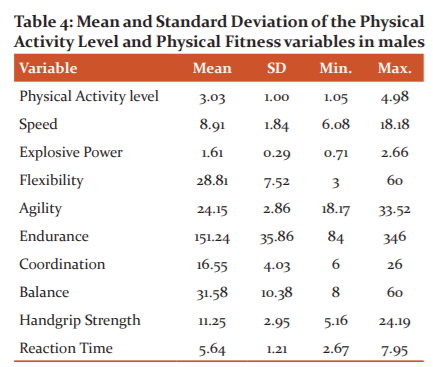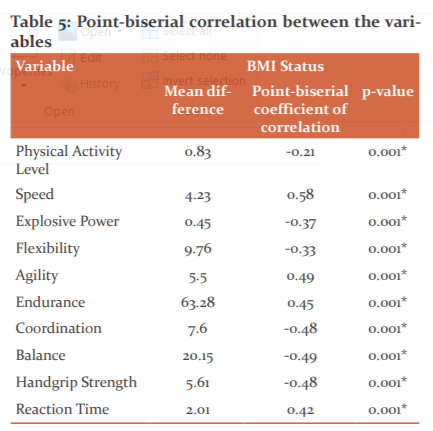IJCRR - 13(12), June, 2021
Pages: 44-48
Date of Publication: 22-Jun-2021
Print Article
Download XML Download PDF
Physical Activity Levels and Physical Fitness Components in Male Adolescents: Relationship with Overweight and Obesity
Author: Kavita Sharma, Sukhdev Singh, Harmandeep Singh, Amandeep Singh
Category: Healthcare
Abstract:Aim: To examine the relationship of physical activity levels and physical fitness components with overweight and obesity in adolescent boys. Method: We recruited 332 school going boys of age 13-18 years as subjects. The subjects filled a validated questionnaire: Physical Activity Questionnaire-A (PAQ-A) to report their physical activity levels. They were further subjected to the testing of their physical fitness components including speed, explosive power, flexibility, agility, endurance, coordination, balance, handgrip strength and reaction time. The relationship between these variables and overweight and obesity were examined by applying the Point-biserial correlation test. Results: The prevalence of overweight and obesity was 5.42% and 1.51% respectively. Significant correlations were found between the Basal metabolic Index (BMI) status of adolescent boys and their physical activity levels and overall physical fitness status. Conclusion: Overweight and obese adolescent boys had inferior levels of physical activity and physical fitness profile than the non-overweight and obese boys.
Keywords: PAQ, Body mass index, Speed, Flexibility, Endurance, Agility
Full Text:
INTRODUCTION
Childhood obesity is a growing health problem globally attaining rampant magnitudes equally in developed and developing nations.1, 2In India, the prevalence of overall overweight and obesity has been significantly increased from 16.3% in 2001-2005 to 19.3% in 2016.3 Moreover, north India (setting of our study) is more affected by childhood obesity compared to South India.3Alarmingly, the main apprehension with childhood obesity is that 80% of overweight/obese adolescents later turn into the overweight/obese adults and those individuals later demonstrate higher mortality rate because of Cardio Vascular Disease (CVD’s) and digestive ailments in later age.5Furthermore, overweight/obese adolescents have a higher risk of getting asthma at a small age, moreover, there is a higher likelihood of fractures, mortality due to traumatic hurts as compared to non-obese adolescents and exhibiting a weak cardio-respiratory fitness in earlier age.6, 7
Because of this, various parameters are required to be regularly considered to examine overweight in youngsters including BMI, physical activity levels and physical fitness components. Though body mass index is frequently utilized as a functional parameter of complete adiposity in adolescents,8 it appears that body mass index has various confines in examining the occurrence of adiposity, body composition and fat proportion specific to age and gender.9 Contrarily, physical activity levels and physical fitness levels are considered as the major predictors of core adiposity and CVD risk factors contributing to elevated levels of plasma lipids and lipoprotein in adolescents.9 Considering this, we led this study to examine the relationship of overweight and obesity with physical activity level and physical fitness components of male adolescents.
METHODS
Subjects
The study participants were selected from different schools of District Amritsar of Punjab, India. The study participants were 332 males adolescents of age ranged from 13-18 years. The conventional approach of sampling was followed to locate the participants.
Data collection
Physical Activity levels
A self-administered questionnaire PAQ-A was used to assess the levels of physical activity.10 It is appropriate for administration on 13 to 19-year-olds. It consists of 8 items that provide physical activity data of the last seven days. Each item was scored on a 5-point scale.
Physical Fitness Components
All the physical fitness components along with their purpose and respective tests are mentioned in table 1.
Overweight and Obesity
The body mass index (BMI) was calculated by dividing the weight in kilograms by height meter squared. The following cut-offs were used to estimate the body mass index is given in table 2:
Statistical Analysis
The descriptive figures of the parameters Physical Activity Level and Physical Fitness components were presented as mean, standard deviation and minimum and maximum values. Since the dependent variable overweight/obese was categorical, its relationship with the number of independent variables was examined by running Pearson’s Point-biserial correlation. The significance level was at 0.05. All the analyses were performed on IBM SPSS version-21.
Ethical approval and consent: The study was ethically approved by the Department of Physical
Education (T), Guru Nanak Dev University, Amritsar. The informed consent was taken from all
the participants before data collection.
Ethical approval and consent: The study was ethically approved by the Department of Physical
Education (T), Guru Nanak Dev University, Amritsar. The informed consent was taken from all
the participants before data collection.
Ethical approval and consent: The study was ethically approved by the Department of Physical Education (T), Guru Nanak Dev University, Amritsar. The informed consent was taken from all the participants before data collection.



Table 3 shows the mean and standard deviations of demographics of male adolescents. The mean and standard deviation of the age was 15.61 and 1.26 years respectively. The mean value of height was 1.66 meters with a standard deviation of 0.08. The mean and standard deviation of weight was 56.81 Kgs and 7.91 respectively. Of the total sample, 2.11% were found underweight, 90.96% possessed normal weight, 5.42% were overweight and 1.51% were found obese as per the BMI cut off values.

Table 4 demonstrates the descriptive statistics of physical activity level and the variables of physical fitness in males. The mean score and standard deviation of physical activity level were 3.03 and 1.00 respectively with the score range of 1.05 to 4.98. The mean score and standard deviation of Speed were 8.91 and 1.84 seconds respectively with the score range of 6.08 to 18.18. The mean score and standard deviation of Explosive Power were 1.61 and 0.29 meters respectively with the values ranging from 0.71 to 2.66. The mean value and standard deviation of Flexibility were 28.81 and 7.52 centimetres respectively with the score range of 3 to 60. The mean score and standard deviation of Agility were 24.15 and 2.86 seconds respectively with the score range of 18.17 to 33.52. The mean score and standard deviation of Endurance were 151.24 and 35.86 seconds respectively with the score range of 84 to 346. The mean score and standard deviation of Coordination were 16.55 and 4.03 respectively with the score range of 6 to 26. For Balance, the mean value was 31.58 and the standard deviation was 10.38. The score of Balance ranged from 8 to 60. For Handgrip Strength, the mean value was 11.25 with a standard deviation of 2.95. The minimum value of Handgrip Strength was 5.16 and the maximum was 24.19. The mean value of Reaction time was 5.64 with the standard deviation of 1.21 and minimum and maximum values ranged from 2.67 to 7.95 respectively.

Table 5 outlines the relationship of physical activity levels and physical fitness components with overweight and obesity. As shown in table 5, all the variables were significantly correlated with the overweight and obesity. Physical activity level showed a weak negative correlation (r = -0.21, <0.05) with the overweight and obesity having a mean difference of 0.83 with non-overweight/obese individuals. Speed showed a good positive correlation (r = 0.58,<0.05) with the mean difference of 4.23 seconds. Othervariables of physical fitness showed moderate correlation such explosive power (r = -0.37 <0.05), flexibility (r = -0.33,<0.05), agility (r = 0.49 <0.05), endurance (r = 0.45,<0.05), coordination (r = -0.48,<0.05), balance (r = -0.49,<0.05), handgrip strength (r = -0.48,<0.05), and reaction time (r = 0.42,<0.05).
DISCUSSION
This study aimed to examine the relationship of physical activity levels and physical fitness components with overweight and obesity. We found that physical activity levels and all the physical fitness components were significantly correlated with being overweight and obese. However, the relationship between physical activity levels and overweight/obesity was negative which means that overweight and obese adolescents had lower levels of physical activity levels than non-overweight/obese adolescents. Similar to our results, a previous study found that children with overweight and obesity could not achieve the minimum guidelines of 60-minute activity/day.11Their study further suggested that fulfilling the 60-minute guidelines could reduce the chances of overweight and obesity by 49%.11
We also tested the correlation between the number of physical fitness components and overweight and obesity. Smith et al.,11 conducted a similar study and revealed that normal-weight boys of age 7-15 were better than overweight and obese on the variables speed, agility, endurance, explosive power of legs, the strength of upper limbs, and muscular resistance whereas they found no significant differences for the flexibility and muscular power of upper limbs. However, we found that overweight and obese adolescents have significantly lower speed, explosive power, flexibility, agility, endurance, coordination, balance, handgrip strength and reaction time than the non-overweight and obese adolescents. Our results are also in agreement with the results of a previous study on the young people of age 12-15 years which revealed that normal-weight adolescents were better on seven physical fitness tests out of nine tests.14
The prevalence of overweight (5.42%) and obesity (1.51%) was also lower in our study than the previous studies.12, 14 Regarding handgrip strength, a study on Flemish youths found that obese ones had better handgrip strength than the non-obese ones.13 Flexibility is another variable that shows contrary results to the previous studies as they found that obese ones had better flexibility than those possessing the normal weight.12, 15, 16
CONCLUSION
Our study concluded that non-overweight and obese adolescent boys had better physical activity levels and physical fitness status than the overweight and obese adolescent boys. From the above results and discussion, it is obvious that adolescents with healthy weight possess a better physical fitness profile and overall physical activity levels.
RELEVANCE
Since physical activity, physical fitness and healthy eating habits are linearly linked to sound health and well-being, the findings of this can be used by health professionals to study the prevalence and patterns of non-communicable diseases (NCDs) specifically cardiovascular diseases.
RECOMMENDATIONS
Policy interventions by the governments are required to address the issue of overweight/obesity in children and adolescents.
ACKNOWLEDGEMENTS
The authors are thankful to the participants for their kind cooperation in this research project.
AUTHOR’S CONTRIBUTION
Conceptualization: Kavita Kumar, Sukhdev Singh, Amandeep Singh; Methodology: Kavita Sharma, Harmandeep Singh, Amandeep Singh; Formal analysis and investigation: Kavita Sharma, Harmandeep Singh; Writing - original draft preparation: Harmandeep Singh, Kavita Sharma; Writing - review and editing: Harmandeep Singh, Kavita Sharma, Sukhdev Singh; Supervision: Sukhdev Singh, Amandeep Singh
References:
-
Gomes TN, Katzmarzyk PT, Dos Santos FK, Souza M, Pereira S, Maia JA. Overweight and obesity in Portuguese children: prevalence and correlates. Int J Env Res Public Health. 2014 Nov;11(11):11398-417.
-
Ebbeling CB, Pawlak DB, Ludwig DS. Childhood obesity: public-health crisis, common sense cure. The lancet. 2002 Aug 10;360(9331):473-82.
-
Ranjani H, Mehreen TS, Pradeepa R, Anjana RM, Garg R, Anand K, Mohan V. Epidemiology of childhood overweight & obesity in India: A systematic review. Ind J Med Res. 2016 Feb;143(2):160.
-
Whitaker RC, Wright JA, Pepe MS, Seidel KD, Dietz WH. Predicting obesity in young adulthood from childhood and parental obesity. New Eng J Med. 1997 Sep 25;337(13):869-73.
-
Mossberg HO. 40-year follow-up of overweight children. The Lancet. 1989 Aug 26;334(8661):491-3.
-
Loid P, Goksör E, Alm B, Pettersson R, Möllborg P, Erdos L, et al. A persistently high body mass index increases the risk of atopic asthma at school age. Acta Paediatr. 2015 Jul;104(7):707-12.
-
Kim SJ, Ahn J, Kim HK, Kim JH. Obese children experience more extremity fractures than nonobese children and are significantly more likely to die from traumatic injuries. Acta Paediatr. 2016 Oct;105(10):1152-7.
-
Ogden CL, Flegal KM, Carroll MD, Johnson CL. Prevalence and trends in overweight among US children and adolescents, 1999-2000. J Ame Med Asso. 2002 Oct 9;288(14):1728-32.
-
Savva SC, Tornaritis M, Savva ME, Kourides Y, Panagi A, Silikiotou N, et al. Waist circumference and waist-to-height ratio are better predictors of cardiovascular disease risk factors in children than body mass index. Int J Obes (Lond). 2000 Nov;24(11):1453-8.
-
Kowalski KC, Crocker PR, Kowalski NP. Convergent validity of the physical activity questionnaire for adolescents. Pediatr Exerc Sci. 1997 Nov 1;9(4):342-52.
-
Hong I, Coker-Bolt P, Anderson KR, Lee D, Velozo CA. Relationship between physical activity and overweight and obesity in children: Findings from the 2012 National Health and Nutrition Examination Survey National Youth Fitness Survey. Am J Occup Ther. 2016 Sep 1;70(5):7005180060p1-8.
-
Dumith SC, Ramires VV, Souza MA, Moraes DS, Petry FG, Oliveira ES, et al. Overweight/obesity and physical fitness among children and adolescents. J Phys Act Health. 2010 Sep 1;7(5):641-8.
-
Deforche B, Lefevre J, De Bourdeaudhuij I, Hills AP, Duquet W, Bouckaert J. Physical fitness and physical activity in obese and nonobese Flemish youth. Obes Res. 2003 Mar;11(3):434-41.
-
Bovet P, Auguste R, Burdette H. Strong inverse association between physical fitness and overweight in adolescents: a large school-based survey. Int J Behav Nutr Phys Act. 2007 Dec;4(1):24.
-
Fogelholm M, Stigman S, Huisman T, Metsämuuronen J. Physical fitness in adolescents with normal weight and overweight. Scand J Med Sci Sports. 2008 Apr;18(2):162-70.
-
Tokmakidis SP, Kasambalis A, Christodoulos AD. Fitness levels of Greek primary schoolchildren in relationship to overweight and obesity. Eur J Pediatr. 2006 Dec 1;165(12):867-74.
|






 This work is licensed under a Creative Commons Attribution-NonCommercial 4.0 International License
This work is licensed under a Creative Commons Attribution-NonCommercial 4.0 International License